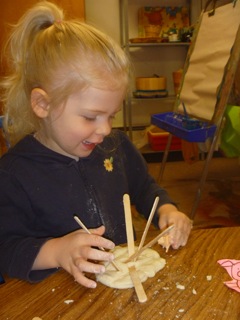Having Tea with our Furry Friends/Getting Some Healthy Sensory Experience . . .
We brought our furry friends to school this week . . .
We had some "tea" with them.
This was a good opportunity to use eye-hand control while pouring!
Outside we snuggled with our animals in our "fort".
. . . and tried teeter tottering ALL together!
We made houses for our friends in the block area, too.

On our rainy day the M/W/F group made warm bread to eat . . .



That morning we learned how to put on our own coats! (the children
really wanted to go outside in the rain - we went for about 7 minutes!)

We had fun splashing around!


Additional experiences this week entailed gearing up to explore some sensory substances! Below is a short quote from a fun website I found that nicely puts into words, my belief and training, on why and how sensory experience is so important at this age, as well as the language development that can occur when we play
together!
The senses are young children's most familiar, most basic way to explore, process, and come to understand new information.
This is why we must allow young children to learn through experience, not just lecture. These children need to use their senses and be engaged in meaningful experiences. As we talk with them about what they are observing and sensing, we give them new language tools to connect with these more familiar sensory tools, building language as well as supporting cognitive concepts specific to the experience.
Now,
the flip side to this equation is important to remember as well. Just as children learn through their senses, they also are developing the ability to use those senses and are building the
neurological pathways associated with each one. With added sensory experiences, combined with the
scaffolding of adults and peers, children become more perceptive. Their sensory intake and processing becomes more acute.
As they are better able to use their senses, they are then better able to learn through their senses.
notjustcute.com

It took some of us awhile, but soon we were enjoying the various sensations and qualities of
"Gak" and shaving cream.



Bridget used nice broad strokes on the big paper - this is good exercise for crossing the mid-line.
We also used children's chopsticks to pick up items - this is excellent practice for the fine muscles in the hand.
Colin worked very hard to finally pick something up!
The T/Th group enjoyed making toast and butter one day for snack . . .
Using utensils purposefully is another good fine muscle and eye-hand activity.
YUM!
We had a nice combination, this week, of child-generated activities, as well as some intentionally planned, fun, and purposeful projects that help us develop physically as well as socially. Good job, kids!
































































